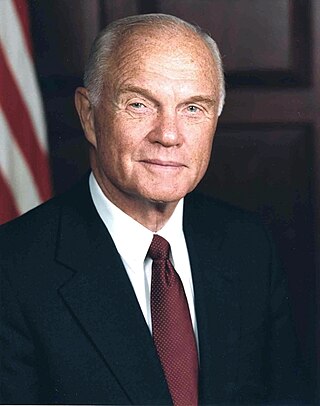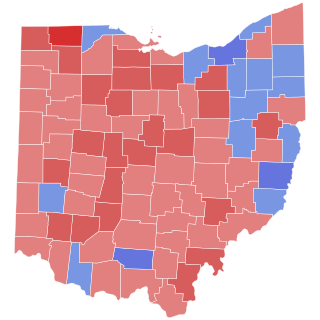
John Herschel Glenn Jr. was an American Marine Corps aviator, astronaut, businessman, and politician. He was the third American in space and the first American to orbit the Earth, circling it three times in 1962. Following his retirement from NASA, he served from 1974 to 1999 as a U.S. Senator from Ohio; in 1998, he flew into space again at the age of 77.

Howard Morton Metzenbaum was an American politician and businessman who served for almost 20 years as a Democratic member of the U.S. Senate from Ohio. He also served in the Ohio House of Representatives and Senate from 1943 to 1951.

Oliver Payne Bolton was an American politician of the Republican Party who served in the United States House of Representatives from 1953 to 1957 and from 1963 to 1965. In 1953, he and his mother, Frances P. Bolton, became the first mother and son to serve simultaneously in Congress. His father, Chester C. Bolton, also served in Congress.

The 1974 United States Senate elections were held on November 5, with the 34 seats of Class 3 contested in regular elections. They occurred in the wake of the Watergate scandal, Richard M. Nixon's resignation from the presidency, and Gerald Ford's subsequent pardon of Nixon. Economic issues, specifically inflation and stagnation, were also a factor that contributed to Republican losses. As an immediate result of the November 1974 elections, Democrats made a net gain of three seats from the Republicans, as they defeated Republican incumbents in Colorado and Kentucky and picked up open seats in Florida and Vermont, while Republicans won the open seat in Nevada. Following the elections, at the beginning of the 94th U.S. Congress, the Democratic caucus controlled 60 seats, and the Republican caucus controlled 38 seats.

The 1970 United States Senate elections was an election for the United States Senate. It took place on November 3, with the 33 seats of Class 1 contested in regular elections. Special elections were also held to fill vacancies. These races occurred in the middle of Richard Nixon's first term as president. The Democrats lost a net of three seats, while the Republicans and the Conservative Party of New York picked up one net seat each, and former Democrat Harry F. Byrd Jr. was re-elected as an independent.

The 1964 United States Senate elections were held on November 3. The 33 seats of Class 1 were contested in regular elections. Special elections were also held to fill vacancies. They coincided with the election of President Lyndon B. Johnson by an overwhelming majority, to a full term. His Democratic Party picked up a net two seats from the Republicans. As of 2023, this was the last time either party has had a two-thirds majority in the Senate, which allowed the Senate Democrats to override a veto, propose constitutional amendments, or convict and expel certain officials without any votes from Senate Republicans. However, internal divisions would have prevented the Democrats from having done so. The Senate election cycle coincided with Democratic gains in the House in the same year.

The 1992 United States Senate election in Ohio was held on November 3, 1992. Incumbent Democratic U.S. Senator John Glenn defeated Republican Lieutenant Governor Mike DeWine to win re-election to a fourth term, coinciding with the presidential election.

An astronaut-politician is a person who has entered politics after traveling to space as an astronaut. Even with the increasing number of individuals who have flown in space, astronauts still maintain a wide degree of public recognition, and those interested in pursuing a career in politics have been able to take advantage of their renown to enter politics at higher levels of elected office.

The 1986 United States Senate election in Ohio took place on November 4, 1986. It was concurrent with elections to the United States House of Representatives. Incumbent Democratic U.S Senator John Glenn won re-election to a third term.

The 1980 United States Senate election in Ohio took place on November 4, 1980. It was concurrent with elections to the United States House of Representatives. Incumbent Democratic U.S. Senator John Glenn won re-election to a second term in a landslide with nearly 69% of the vote, coinciding with Ronald Reagan's substantial win in the state during the presidential election. Glenn carried all but one of the state's 88 counties, only losing Paulding County.

The 1974 United States Senate election in Ohio took place on November 5, 1974. It was concurrent with elections to the United States House of Representatives. Incumbent Democratic U.S Senator Howard Metzenbaum was running for election his first full term after he was appointed in 1974 by Ohio governor John J. Gilligan to fill out the Senate term of William B. Saxbe, who had resigned to become United States Attorney General. Metzenbaum lost the primary election to John Glenn, who went on to win the general election and win every county in the state. Metzenbaum would later be elected in the other U.S. Senate seat in 1976 and worked with Glenn until he retired from the post in 1994.

The 1976 United States Senate election in Ohio took place on November 2, 1976. Incumbent Republican senator Robert Taft, Jr. ran for re-election to second term. Democrat Howard Metzenbaum, who had briefly served in the Senate in 1974, unseated Taft in a rematch of the 1970 election.

The 1946 United States Senate elections in Ohio was held on November 5, 1946, alongside a concurrent special election to the same seat.

The 1970 United States Senate election in Ohio took place on November 3, 1970. Incumbent Democratic Senator Stephen M. Young did not run for re-election to a third term in office. U.S. Representative Robert Taft Jr. won the open seat over Democrat Howard Metzenbaum.

The 1956 United States Senate election in Ohio took place on November 6, 1956. Incumbent Senator George H. Bender, who won a special election to complete the term of the late Senator Robert A. Taft, ran for re-election to a full six-year term. He was defeated by Democratic Governor Frank Lausche. As of 2022, this is the last time that an incumbent Senator from Ohio lost re-election for this seat.

The 1950 United States Senate election in Ohio took place on November 7, 1950. Incumbent Senator Robert A. Taft was elected to a third term in office, easily defeating Democratic State Auditor and 1944 presidential candidate Joseph T. Ferguson.

The 1944 United States Senate election in Ohio took place on November 7, 1944. Incumbent Republican Senator Robert A. Taft, first elected in the Republican wave of 1938, was narrowly elected to a second term in office over Democratic former Lieutenant Governor William G. Pickrel, winning 71 of Ohio's 88 counties. Despite Pickrel winning the state's largest urban centers such as Cleveland, his margins there were overcome by Taft's strong showings in the rural areas and small towns. Nevertheless, at less than a point, Taft's victory was significantly smaller than his 7-point win in 1938.

The 1938 United States Senate election in Ohio took place on November 8, 1938. Incumbent Senator Robert J. Bulkley ran for re-election to a second full term in office, but was defeated by the Republican nominee, former state Senator Robert A. Taft, the elder son of former President and supreme court chief justice William Howard Taft. Taft's victory was a part of a major Republican wave nationally, where Republicans gained 8 Senate seats and 81 seats in the House of Representatives, which was largely attributable to incumbent Democratic President Franklin Roosevelts's unpopularity in the aftermath of the Recession of 1937–1938 and the President's controversial plan to add more seats to the Supreme Court, which he proposed after the court ruled some of his New Deal programs unconstitutional. Taft's victory marked the beginning of 4 consecutive Republican victories in this seat, and Democrats would not win it again until Governor Frank Lausche won it in 1956.

The United States Senate special election in Ohio of 1954 was held on November 2, 1954 to complete the unexpired term of late Senator Robert A. Taft, who died in office on July 31, 1953. Interim Senator Thomas A. Burke ran to complete the term in office but was narrowly defeated by U.S. Representative George Bender.

The 1964 United States Senate election in California was held on November 3, 1964.























